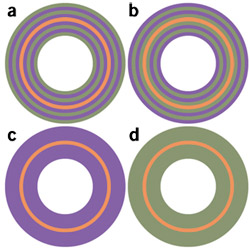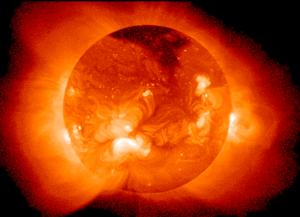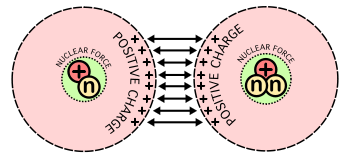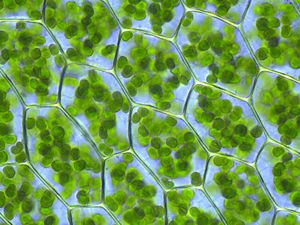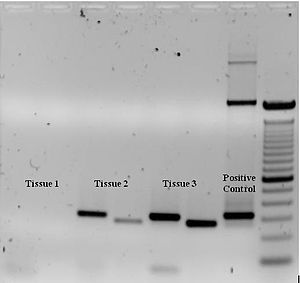MATHEMATICS
Combination
(http://en.wikipedia.org/wiki/Combination)
In mathematics, a combination is a way of selecting members from a grouping, such that (unlike permutations) the order of selection does not matter. In smaller cases it is possible to count the number of combinations. For example given three fruits, say an apple, an orange and a pear, there are three combinations of two that can be drawn from this set: an apple and a pear; an apple and an orange; or a pear and an orange. More formally, a k–combination of a set S is a subset of k distinct elements of S.
If the set has n elements, the number of k-combinations is equal to the binomial coefficient
 or written as
or written as 
Number of k-combinations from given set S of n elements often denoted as C(n,k).
e.g. 3-element subsets of a 5-element set
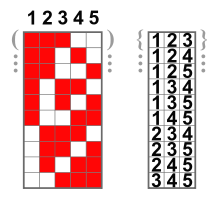
Bijection between 3-subsets of a 7-set (left) and 3-multisets with elements from a 5-set (right)

Pascal’s Triangle

In mathematics, Pascal’s triangle is a triangular array of the binomial coefficients. It is named after the French mathematician Blaise Pascal in much of the Western world, although other mathematicians studied it centuries before him in India, Iran, China, Germany, and Italy.
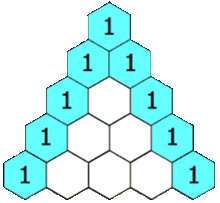
The rows of Pascal’s triangle are conventionally enumerated starting with row n = 0 at the top. The entries in each row are numbered from the left beginning with k = 0 and are usually staggered relative to the numbers in the adjacent rows. A simple construction of the triangle proceeds in the following manner. On row 0, write only the number 1. Then, to construct the elements of following rows, add the number above and to the left with the number above and to the right to find the new value. If either the number to the right or left is not present, substitute a zero in its place. For example, the first number in the first row is 1 (the sum of 0 and 1), whereas the numbers 1 and 3 in the third row are added to produce the number 4 in the fourth row.
Other countries:
Yang Hui triangle
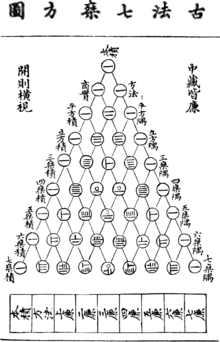

Yang Hui (Pascal’s) triangle, as depicted by the Chinese using rod numerals.
Rod numerals are small bars used by mathematicians for calculation in ancient China, Japan, Korea and Vietnam. They are either placed horizontally or vertically to represent any number and any fraction.
Magic square
(http://en.wikipedia.org/wiki/Magic_square)
In recreational mathematics, a magic square is an arrangement of distinct numbers (i.e. each number is used once), usually integers, in a square grid, where the numbers in each row, and in each column, and the numbers in the forward and backward main diagonals, all add up to the same number.
Normal magic squares of all sizes except 2 × 2 (that is, where n = 2) can be constructed. The 1 × 1 magic square, with only one cell containing the number 1, is trivial. The smallest (and unique) nontrivial case, 3 × 3, is shown below.

Geometric Magic Square
(http://en.wikipedia.org/wiki/Geometric_magic_square)
traditional magic square is a square array of numbers (almost always positive integers) whose sum taken in any row, any column, or in either diagonal is the same target number.




A geomagic square, on the other hand, is a square array of geometrical shapes in which those appearing in each row, column, or diagonal can be fitted together to create an identical shape called the target shape.
Magic circle
(http://en.wikipedia.org/wiki/Magic_circle_(mathematics))

Invented by the Song dynasty (960–1279) Chinese mathematician Yang Hui (c. 1238–1298). It is the arrangement of natural numbers on circles where the sum of the numbers on each circle and the sum of numbers on diameter are identical. One of his magic circles was constructed from 33 natural numbers from 1 to 33 arranged on four concentric circles, with 9 at the center.
Yang Hui’s magic concentric circle has the following properties
- The sum of the numbers on four diameters = 147,
- 28 + 5 + 11 + 25 + 9 + 7 + 19 + 31 + 12 = 147
- The sum of 8 numbers plus 9 at the center =147;
- 28 + 27 + 20 + 33 + 12 + 4 + 6 + 8 + 9 = 147
- The sum of eight radius without 9 =magic number 69: such as 27 + 15 + 3 + 24 = 69
- The sum of all numbers on each circle (not including 9) = 2 × 69
There exist 8 semicircles, where the sum of numbers = magic number 69; there are 16 line segments(semi circles and radii) with magic number 69, more than a 6 order magic square with only 12 magic numbers.

Yang Hui 8 magic circles in a square 八阵图
64 numbers arrange in circles of eight numbers, total sum 2080, horizontal / vertical sum =260.
Patterns obtained
Sierpinski triangle


The pattern obtained by coloring only the odd numbers in Pascal’s triangle closely resembles the fractal called the Sierpinski triangle. This resemblance becomes more and more accurate as more rows are considered; in the limit, as the number of rows approaches infinity, the resulting pattern is the Sierpinski triangle, assuming a fixed perimeter. More generally, numbers could be colored differently according to whether or not they are multiples of 3, 4, etc.; this results in other similar patterns.
fractal and attractive fixed set with the overall shape of an equilateral triangle, subdivided recursively into smaller equilateral triangles. Originally constructed as a curve, this is one of the basic examples of self-similar sets, i.e. it is a mathematically generated pattern that can be reproducible at any magnification or reduction.
Koch snowflake

The Koch snowflake (also known as the Koch star and Koch island) is a mathematical curve and one of the earliest fractal curves to have been described. It is based on the Koch curve, which appeared in a 1904 paper titled “On a continuous curve without tangents, constructible from elementary geometry”
Tesselation of Koch snowflake

Fractals by Hausdorff dimensions
(http://en.wikipedia.org/wiki/List_of_fractals_by_Hausdorff_dimension)
According to Falconer, one of the essential features of a fractal is that its Hausdorff dimension strictly exceeds its topological dimension. Presented here is a list of fractals ordered by increasing Hausdorff dimension, with the purpose of visualizing what it means for a fractal to have a low or a high dimension.




